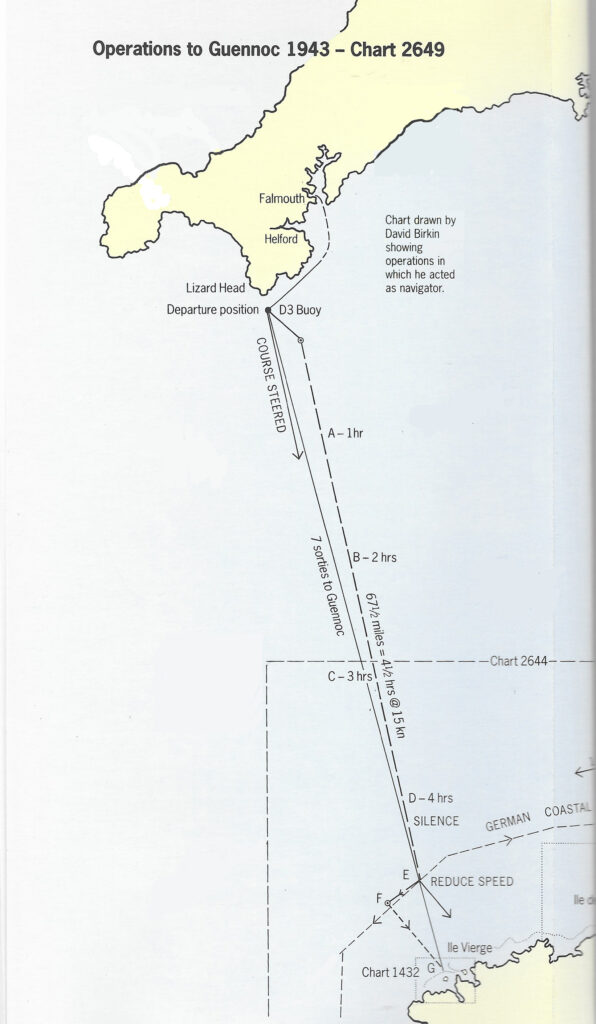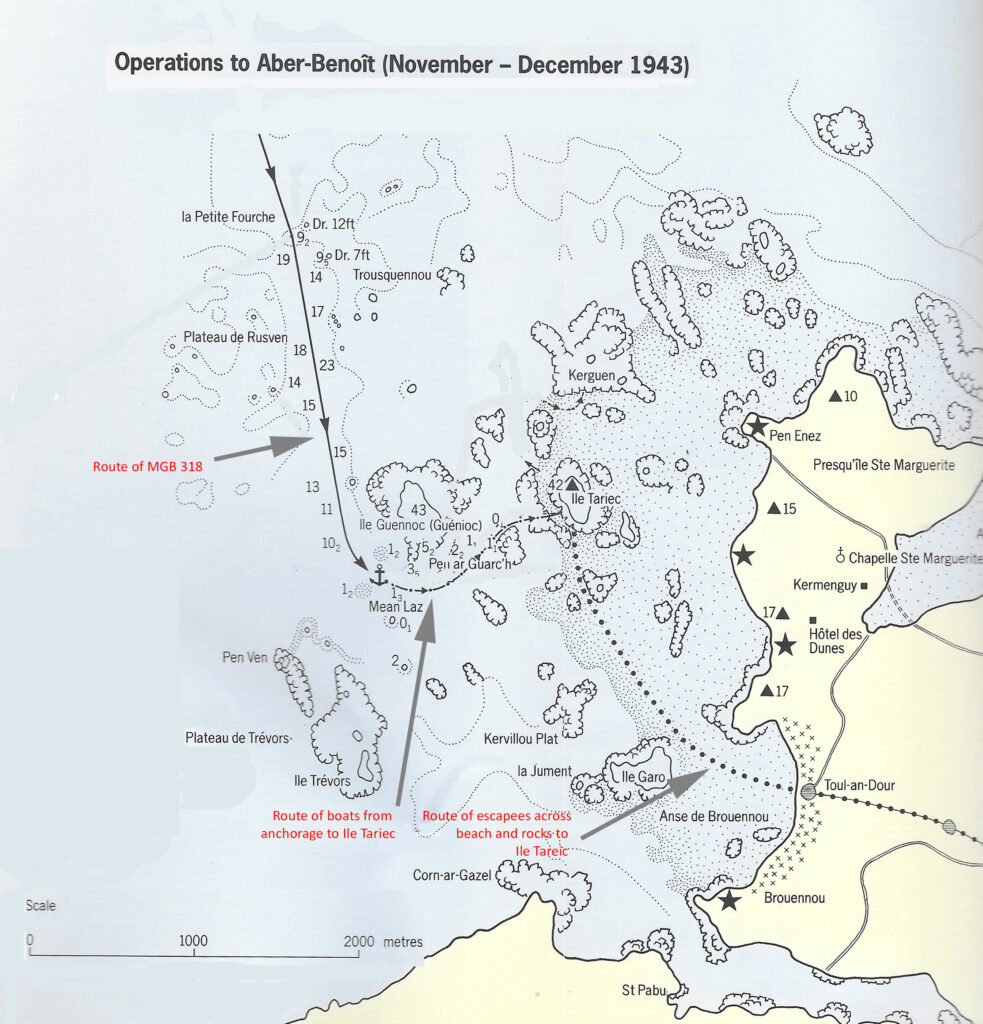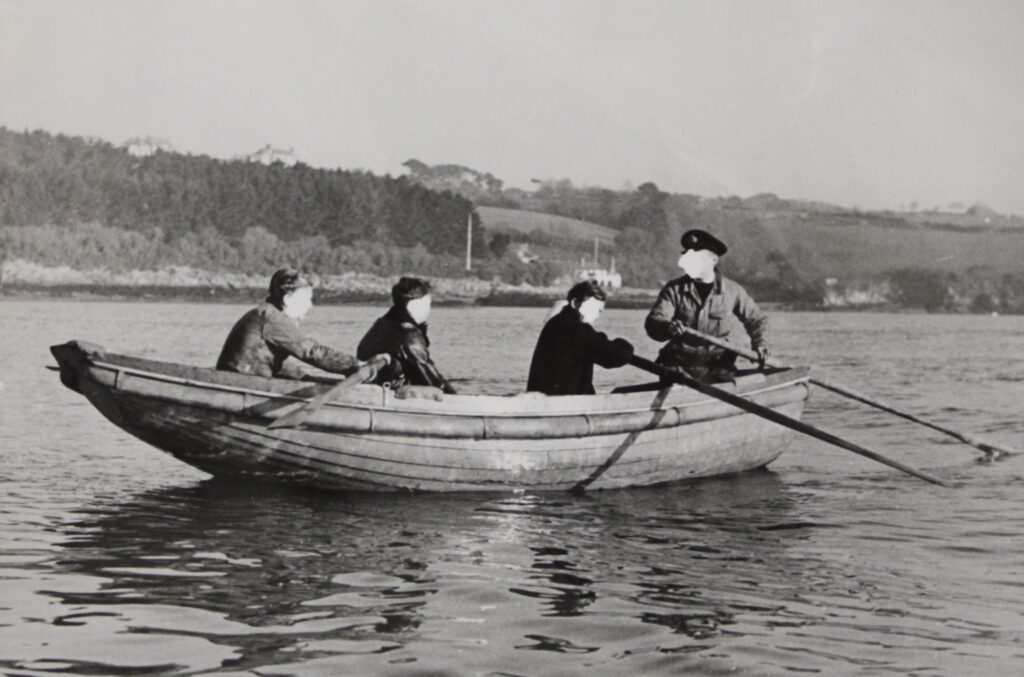Operation FELICITATE was the pinnacle of achievement for the Inshore Patrol Flotilla (IPF) and SOE Helford Base: an unconventional solution produced under pressure. The operations in November and December 1943 highlight some of the problems that the IPF and 15th Flotilla faced in crossing to and from France: very tricky navigation, difficult sea and weather conditions, poor communications and the wrong kind of boats.
By the end of 1943, there was a series of networks in operation in Brittany requiring agents to make regular trips, and mail and supplies to be delivered. There were also an increasing number of Allied pilots and escapees who needed to be re-patriated, or in the jargon of the time, ‘exfiltrated’. The resistance group in the Aber-Benoît area of NW Brittany had collected nearly 20 people who were keen to leave France. It would take five attempts to collect them.
ENVIOUS – November and early December1
The first attempt was launched on the night of 2/3 November, called operation ENVIOUS. Its objective was to collect 15 people from the L’Abervac’h area. Launched from Falmouth using a Fairmile type ‘C’ boat, MGB 318, skippered by a South African, Lt Jan McQuoid Mason SANF(V) it was led by Lt Cdr Davis. The navigator was Lt David Birkin RNVR and the boats were under the command of an Australian-Tasmanian, Lt ‘Tassy’ Uhr-Henry RANVR.

ENVIOUS established the basic pattern for such operations. They chose moonless nights, leaving Falmouth late in the afternoon with a fighter escort overhead until darkness fell, and then navigated in the pitch dark until they could pick up a landmark. The lighthouses were switched off; GPS did not exist and such radar systems as existed were inaccurate and temperamental. This was ‘old style’ navigation.

The destination was a series of rocky ledges, surrounded by treacherous reefs which were uncovered at low tide. The intention was that MGB 318 would silently approach the coast, drop anchor off a small rocky islet called Ile Tariec and then launch its boats. These would be rowed for about a mile over to the neighbouring Ile Guennoc, where they would land, collect the passengers and row back to the mother ship. All of this was to be carried out in the dark, in waters which the Pilot warns should not be attempted, even in daylight, without an experienced pilot who knows the area. There was also the chance of an enemy patrol on land, sea or area, turning up at an inconvenient moment.

The heights are in ft, the depths in fathoms (6ft)
MGB 318 would then have to be away and sufficiently far out to sea to avoid any enemy air patrol before dawn broke, eventually meeting their fighter escort off the Lizard, for the return to the mouth of the Helford where they would transfer their agents to IPF’s RAF 360, before returning to Falmouth.
All went well on the approach. MGB 318 anchored and launched her boats successfully but then things went wrong. There was no ship to shore communication system and the use of lights was out of the question. The boats and the welcoming committee missed each other in the dark and the boats returned to MGB 318 empty handed, leaving the poor escapees on the exposed rock of Ile Guennoc. They remained there overnight before they were rescued by the French resistance. MGB 318 returned to Falmouth.
ENVIOUS II and IIb
They tried again in ENVIOUS II on 26/27 November. The same team went to the same location, this time to land an agent and collect 6 escapees. However, this time, the reception committee had gone to another beach. They did manage to land the agent and returned home. Again, local communications had let them down.
ENVIOUS IIb followed on 1st/2nd December. This time, they were aiming to collect 20 people and deliver some stores from Helford. Because of the numbers, two MGBs were sent, the familiar MGB 318 commanded by Lt Mason with navigator Lt Birkin and Lt Uhr-Henry on boats, and MGB 329 with Lt Pollard on boats.

This was the type of boat used for ENVIOUS and FELICITATE
All went well on the way in: the stores and agent were landed and the escapees were loaded but then the weather deteriorated with rain and winds of Force 6/7. No matter how hard the crew rowed, two of the three boats simply could not reach the mother ship, finally giving up and landing on the rocky islet. Lt Uhr-Henry’s boat, by now awash with water, just managed to reach MGB 318 with its 7 escapees. The other two boats were scuttled and Lt Pollard and five naval personnel were now stuck in France, in the care of the resistance.
The return journey was horrible and it was not until 17:20 that MGB 318 and its very sea-sick crew reached Falmouth, having taken many hours longer than usual. Ship to shore communications had worked better but there this time the weather had beaten them.
FELICITATE – Late December
The IPF was not going to give up and operation FELICITATE was planned for the first available weather window which came on 23/24th December. Once again MGB 318 was used commanded by Lt Mason with Lt Birkin whose masterly navigation had been so successful so far. In place of Lt Cdr Davis they were now led by Lt Steven McKenzie, whose experience went back to the days of the French fishing boat operations of 1941, and Lt Uhr-Henry once again in charge of the boats. There were 25 people waiting for them on the beach.
To make the rowing easier on the way in, Tassy put all four oarsmen in one boat and towed the second PD 1 18ft dory, intending to separate them for the return journey. After two hours rowing in a Force 4 wind, it was clear that they would never be able to reach the beach and they gave up. The second boat was scuttled and Tassy and his crew returned to MGB 318 and home. It was Christmas Eve.
The sense of disappointment comes across in all the reports. Four successive operations had failed, either through poor communications or through the use of boats which could not cope with the weather conditions. It was now a high priority to get the escapees out of France, both for security and for credibility.
A hurried conference took place on board Sunbeam II, the headquarters of the IPF. It was clear that larger boats were needed. They could be rowed by four crewmen, could take a larger number of passengers and should be able to cope with adverse winds.
The 25ft SN 2 designed by Lt Cdr Nigel Warington Smyth, the head of the IPF would be ideal but but it was too large to fit on the deck of the gunboat. A month earlier, they had been testing the idea of towing the SN 2 behind a Motor Gunboat and the boat had survived the experience, however, no one knew if it could survive all the way to Brittany. The weather was improving and, with luck, any enemy troops would be celebrating Christmas. It just might be worth a try.

Lt Mason and his crew had had a night’s sleep and were enjoying a Christmas Day lunch in Falmouth when the news came through that the operation was to be repeated later that day. Sleeplessness and hangovers were ignored and MGB 318 once again slipped out of Falmouth to meet the IPF’s RAF 360 towing SN 2 in its wake, off the mouth of the Helford. On board were SOE’s best boat handlers, commanded by ‘Skipper’ Lt Howard Rendle, a Helford man and childhood friend of the Warington Smyth brothers who knew everything there was to know about boats.
Everything went smoothly. SN 2 bounced along in the wake of MGB 318 and once again Lt Birkin found the anchorage with no trouble. The weather was kind and Howard Rendle took SN 2 in alongside a smaller PD 1, before returning for a second trip to collect the stragglers. Some 27 people were rescued: the six crew who had been left behind on 1st/2nd December, five agents and 16 aircrew from a spread of nationalities: English, Australian, Americans and one Polish airmen.2
The overladen MGB 318‘s engines stopped when they were off the Lizard but no one seemed too perturbed and on-board repairs got her going once again. She met RAF 360 at the mouth of the Helford, handing over the escapees and the surfboat before returning to Falmouth. To celebrate, a Boxing Day feast was held in Helford before the 27 were put on the night train to London.
FELICITATE had been a total success. 27 people had been rescued and the idea of towing the large SN 2 surf boat had been a proven success. Amongst the large quantity of mail collected were plans of the V1 and V2 rockets sites in France, which was very valuable information for the High Command. Congratulations flowed from above with an emphasis on the way in which the Navy, SIS and SOE had worked seamlessly as a team, something that would have been inconceivable three years earlier.
- The main sources for this article come from the Operation FELICITATE file in the National Archives: Operational Orders, SOE Logbook, MGB 318 Logbook, Official report and other documents, Helford Base Logbook and associated papers, as well as Lt Cdr B Warington Smyth Short History of SOE Helford Base and Secret Flotillas by Brooks Richards
- Accounts vary on the numbers. Some suggest 30, others mention 28 but the official Log records 27.
